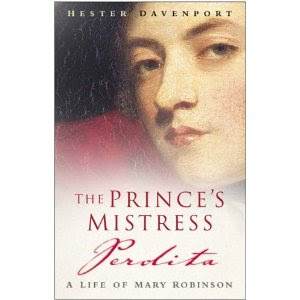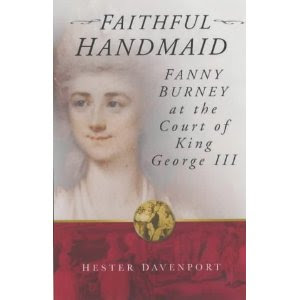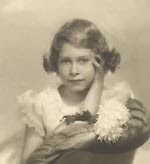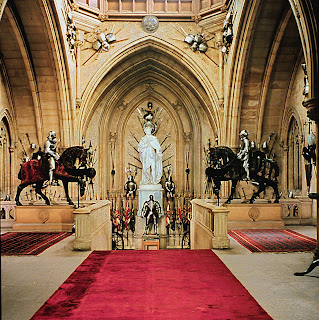The Windsor Guard Parade Arriving at the Castle from Kristine Hughes on Vimeo.
Category: Uncategorized
A Rose By Any Other Name
Victoria here — I suppose we all love roses. I certainly do. I took enough pictures of them in England in June 2010, where they bloomed in all their glory. Here, with minimal words, are some glorious examples.
Street Lights – Royal and Otherwise
Visiting with Hester Davenport in Windsor
 On Tuesday, June 15, Kristine, Brooke and Victoria took the train to Windsor to meet Hester Davenport, a well-known scholar on Fanny Burney and Jane Austen, as well as the author of several books. At right, her biography of Mary Robinson, who was not only the Prince’s Mistress, but an actress, poetess and author as well. More later in this blog.
On Tuesday, June 15, Kristine, Brooke and Victoria took the train to Windsor to meet Hester Davenport, a well-known scholar on Fanny Burney and Jane Austen, as well as the author of several books. At right, her biography of Mary Robinson, who was not only the Prince’s Mistress, but an actress, poetess and author as well. More later in this blog. A better view of the entire structure. Take note of the crooked building at the left. And see below.
A better view of the entire structure. Take note of the crooked building at the left. And see below.o believe a word of it! Caroline Wagstaff’s book tells us that the saying “The world’s my oyster” is first found in a speech by Falstaff in The Merry Wives of Windsor.
 Hester also is the author of Faithful Handmaid: Fanny Burney at the Court of King George III. The mid point of our day with Hester is reported in our blog on Royal Windsor, so now we will skip ahead to later in the afternoon, after we had seen the Queen, the Castle and environs and enjoyed a lovely outdoor luncheon. Brooke left us to survey the shops (and pubs) while Kristine and Victoria continued our adventures with Hester.
Hester also is the author of Faithful Handmaid: Fanny Burney at the Court of King George III. The mid point of our day with Hester is reported in our blog on Royal Windsor, so now we will skip ahead to later in the afternoon, after we had seen the Queen, the Castle and environs and enjoyed a lovely outdoor luncheon. Brooke left us to survey the shops (and pubs) while Kristine and Victoria continued our adventures with Hester. A Visit to Royal Windsor
And when we say Royal, we mean it. When Hester Davenport met us at the train station on the day we went to Windsor, one of the first things she asked Victoria, myself and Brooke was, “I forgot to ask . . . did you want to see the Queen?”
“Ha Ha . . . see the Queen! Really, Hester, you are too funny.”
“No, I mean it,” Hester replied. “I quite forgot when we made our date that today is Royal Ascot. The Royal Family will be leaving the Castle at 1:30. I need to know if you’re interested in seeing them in order to plan our day.”
Were we interested in seeing the Royals?!?
Honestly, I don’t know if all the pomp and circumstance we were treated to from then on was connected to the Royals and Ascot, but the entire day was pretty royal, if you ask us. First of all, we saw the Guards approaching the Castle . . . .
Victoria believes they were Welsh Guards (as seen from the Guildhall).
 Honestly, the entire morning was grand. We bought our Castle tickets and viewed Queen Mary’s Doll House (which is an incredible structure indeed. Maybe I’ll do a blog just on doll houses someday, one of V’s minor passions)
Honestly, the entire morning was grand. We bought our Castle tickets and viewed Queen Mary’s Doll House (which is an incredible structure indeed. Maybe I’ll do a blog just on doll houses someday, one of V’s minor passions)  and visited the nearby exhbition of photos of the young Queen Elizabeth and her late sister Margaret, plus the royal children and grandchildren. Wasn’t (isn’t) she adorable?
and visited the nearby exhbition of photos of the young Queen Elizabeth and her late sister Margaret, plus the royal children and grandchildren. Wasn’t (isn’t) she adorable?What a bunch of tourists.
I blew up a few frames from the video clip, which will give you only a slightly better view of the Queen. And Prince Phillip. Actually, once the motorcade had gone by, I asked Brooke if she’d been able to get a clear view. She said yes, she’d seen just fine. “But,” she said, “Who was that old guy sitting next to the Queen?”

At this point, we returned to the Castle in order to complete our tour, our Royal sightings now just a fond memory. In the above aerial photo, the Queen’s residence in the Upper Ward is at the top, right. The round tower and its garden/moat is in the upper middle, and the state rooms are in the area just above the Round Tower, at the right. Toward the lower left, you can see St. George’s chapel and the middle and lower wards surrounded by thick walls.
Whoops, another royal in the sign on the ticket office, which one suspects might be meant to portray Henry VIII.
Finally, Kristine bought some ornaments to add to her Royal Christmas tree ornament collection, this guard being one of about eight she finally came home with, including ornaments meant to be the young Victoria and Albert.
Tower is the dominant feature of the castle. It is sort of a remnant from the original fortress built here by none other then William the Conqueror almost a thousand years ago.
 The state rooms are overwhelming in their magnificence. These areas have been updated since the days of George IV (1762-1830, but are based on the designs he approved for the remodeling of Windsor. We all know him (once the Prince Regent) as a profligate spender, but much of what he created has lasted quite well. Above, the Grand Staircase.
The state rooms are overwhelming in their magnificence. These areas have been updated since the days of George IV (1762-1830, but are based on the designs he approved for the remodeling of Windsor. We all know him (once the Prince Regent) as a profligate spender, but much of what he created has lasted quite well. Above, the Grand Staircase.When we finished touring the State Rooms in Windsor Castle, we sat outside and rested up (all but the photographer, of course). Left to right: Kristine (holding her ornaments), Brooke (thrilled to have seen Henry VIII’s grave0 and Hester Davenport (the best guide for a day out in Windsor).




